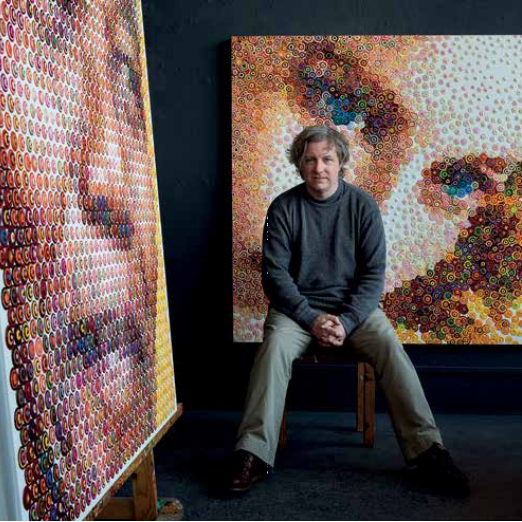Gavin Rain, born in Cape Town on March 23, 1971, studied Art and Neuropsychology at the University of Cape Town in the 1980s and 1990s. He has been painting throughout his life, but he began experimenting with pointillism around 2003/2004. He is influenced by Seurat, early 20th-century Russian avant-garde art, and various architects. Earlier in his life, he planned to study architecture, aiming to merge his interests in art and mathematics. In 2011, Rain participated in the 54th Venice Biennale, at the Pavilion of the Republic of Costa Rica, exhibiting an original portrait of Nobel Peace Prize laureate Aung San Suu Kyi. In 2013, he showcased a piece titled “Lena” at the Pavilion of the Republic of Bangladesh.
Essentially, Gavin Rain ‘s goal is to expand people’s visual and cognitive horizons by showing them the fantastical and the impossible. Combining his background, studies, skills, and personal talent, Rain has created an art form that is both unique and participatory. Anyone looking at one of his paintings can perceive the convergence of two contrasting painting styles: the abstraction of numerous concentric colored circles clustering into dense, imperfect raised points, and the figurative aspect of the image defined by the sum of these points as the viewer steps back.
Moreover, is precisely in this backing-off that the artist’s intended message is found: to become aware of something hidden but right in front of your eyes, or hidden in plain sight, you must move away by stepping back. His art is a clear invitation to “detach,” to create a certain distance in life because, as Gestalt psychology suggests, the whole is greater than the sum of its parts. We must see the big picture, the whole, without getting caught up in isolated events or individual perspectives. Up close, Gavin Rain’s paintings consist of small concentric dots painted in different colors of acrylic paint. From a distance, the eye blends these colors into one. The farther the viewer steps back, the clearer the portrait becomes. He starts his paintings by sketching the portrait he wants to paint.
To decide the placement of the dots on the canvas, he uses a grid, made of strings or a projection. The grid takes about ten hours to create but is more accurate than using a projection, so Rain still employs both techniques. He begins by deciding the final color he wants for a dot and works backward. Rain has a list of 14,000 different dots that he has created. From this list, he chooses the combination that creates the desired color.
Another crucial part of the technique involves varying the size of the dots. The white canvas Rain uses as a background indicates that the smaller the dot, the whiter the background. So, the larger the dots, the darker an area becomes, and the smaller the dots, the lighter the area. This, combined with the distant final color of each dot, is how the image is created. However, the colors of individual dots will blend together into a new color. So, it is not just each dot but also a combination of dots that creates the color.




